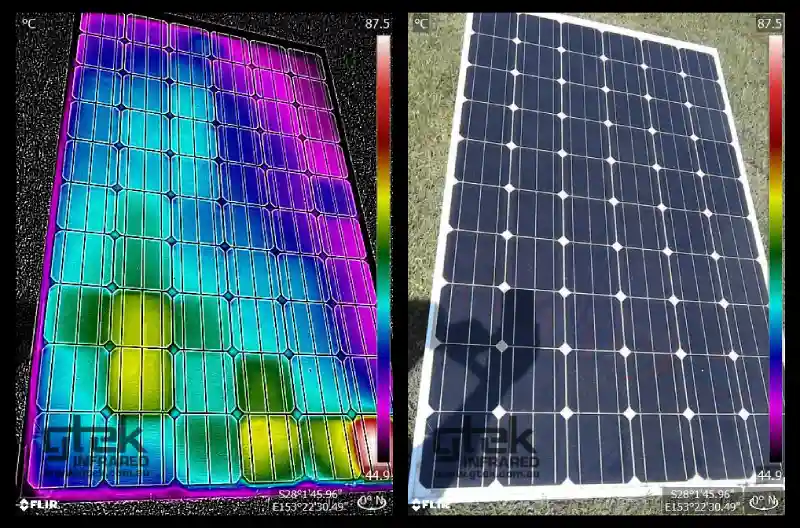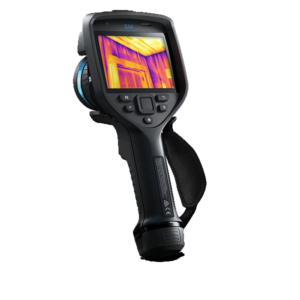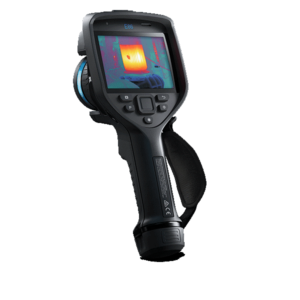GTEK Thermal Imaging Solutions

Teledyne FLIR Australia Thermal Imaging Cameras
GTEK Infrared provides the best IR thermal imaging cameras in Australia. Our thermal cameras are used in a wide range of industries.
Residential and Commercial Building Inspections to detect substandard work, moisture intrusion, and air leaks
Electrical Wiring and Equipment Inspections for predictive maintenance, and to detect hot spots and fire risks
Solar Photovoltaic Inspections to detect solar panel design faults, potential equipment failure, high temperature areas and fire hazards
Transport Inspections for large mining trucks, long haul freight trucks, buses, and other road, air, and maritime vehicles to detect high wear areas, overheating, and mechanical performance
Agricultural Inspections to scan crops for heat stress, moisture content, and the ultimate time to harvest
Get Expert Thermal Camera Advice
Thermal Imaging Building Inspections
Thermal imaging cameras are ideal for building maintenance, and fault detection.
Thermal IR cameras detect temperature variations such as:
- Breaks in wall and roof insulation that cause air leaks
- Air conditioning system performance and heat areas
- Electrical switchboards hot components
- Rising damp, roof leaks, and other plumbing issues
- Heat signatures from termite nests, pest infestations, and animals and vermin including possums and rats

Best IR Cameras for Building Inspections

Thermal Imaging Cameras for Electrical Inspections
Thermal imager surveys help electricians to monitor potential fire risks with residential and commercial assets.
Electricians use thermal infrared cameras to detect and repair phase imbalances, load related faults, hot joints, and high resistance terminations.
These real time electrical surveys are completed with minimum disruption. Thermal cameras also improve on site safety as they offer contactless electrical testing of equipment faults.
Thermal Camera Finds Overheated Electrical Circuits
These images show how a thermal camera can be used to identify components such as energised relays.
This is useful when the electrical enclosure doesn’t have labelling.

Best IR Cameras for Electrical Wiring and Equipment Inspections
Best Thermal Camera Advice Brisbane
Solar Power Thermal Imaging Inspections
Building and solar panel inspectors use thermal IR cameras to assess solar panels for extreme heat points.
Thermal imaging can also be used to detect shorted cells without touching a live electrical device.
Thermal imaging cameras allow solar panel inspectors to assess the fire risk of solar panels and identify dead solar cells.
This image shows five failed cells, with one cell heating up to over 85 degrees.

Best IR Cameras for Solar Photovoltaic Inspections
GTEK Saves You Time and Money
with the Right Thermal Camera and Training
Electrical and Mechanical Transport Inspections
Thermal imaging is used by transport inspectors looking for electrical and mechanical faults. Thermal imagers can detect overheating in vehicles, high wear areas as well as mechanical performance issues.
Thermal Camera Captures Deflated Truck Tyre
Thermal camera transport inspections also monitor wheel groups in large mining dump trucks and long haul freight trucks.
These images show the partial deflation of an inside tyre, resulting in the outside tyre taking on more load.
Outside tyre sidewalls will always show an increase in temperate, either from load or deflection. However, in this case the outside tyre is significantly hotter and displays as red in the thermal image.

Thermal Camera Detects Truck Brake Failure
These images show how thermal imaging can quickly detect a non-functioning brake. The middle axle is cooler than the other axels.

Best IR Cameras for Transport Inspections
Get Expert Thermal Camera Advice
Thermal Imaging for Water Leak Detection
Moisture infiltration and water leaks can cause serious damage to homes and commercial buildings.
Plumbers use thermal imaging cameras to detect temperature differences that reveal hidden water and moisture issues. IR camera inspections are cost effective because a training thermographer can scan for water issues without resorting to destructive testing such as removing wall cladding or flooring.
IR Camera Plumbing and Leak Detection
Water leaks in a caravan are hard to see with the naked eye. However, with the right thermal imaging camera, the water leak is quickly detected. The water ingress can then be blocked, and the damage can be better assessed for repair.
In this case, the caravan owner reported that the was coming from the bathroom into the bedroom. However, the thermal camera found the water was running through the ceiling downs the walls, and into the bedroom.
Thermal imaging not only identified the origin of the water leak but the true extent of the water damage.

In this example, the shower hob was the cause of a water leak. To detect the leak, the plumbing inspector sealed off the drain and filling the hob with hot water. The thermal infrared camera’s quick detection saved time and enabled the leak to be fixed.

In this example, the customer had water entry on the bottom floor of a two-story unit. The thermographic survey revealed a substantial leak in the roof, with the water running down the walls. The use of thermal imaging isolated the water leak and it was quickly fixed.

Best IR Cameras for Plumbers
Need Technical Advice on Your Thermal Camera ?
What is Emissivity in Thermal Imaging?
A working understanding of emissivity is needed to measure absolute temperatures with a thermal IR camera. Emissivity is a measure of how well an object radiates heat. Emissivity is the ratio of heat radiated by the heat radiated compared to the surface captured on the thermal camera.
Emissivity values range from 0 to 1. At one end of the spectrum is a theoretically perfect surface that reflects all energy to a theoretical black body object on the other end of the spectrum that radiates and absorbs energy. However, physical objects typically range from 0.01 to 0.99 on the emissivity scale.
Aluminium, copper, and other highly polished metallic surfaces have an emissivity below 0.10. Roughened metallic surfaces have a much higher emissivity of 0.6 or greater, depending on the amount of oxidation and the surface condition. Water and human skin have an emissivity of 0.98 while flat-finish paints are typically 0.90.







